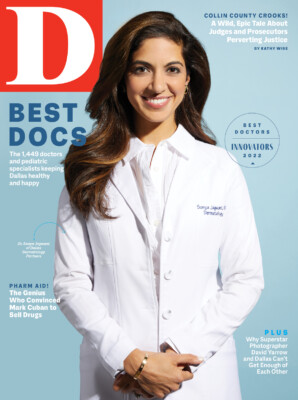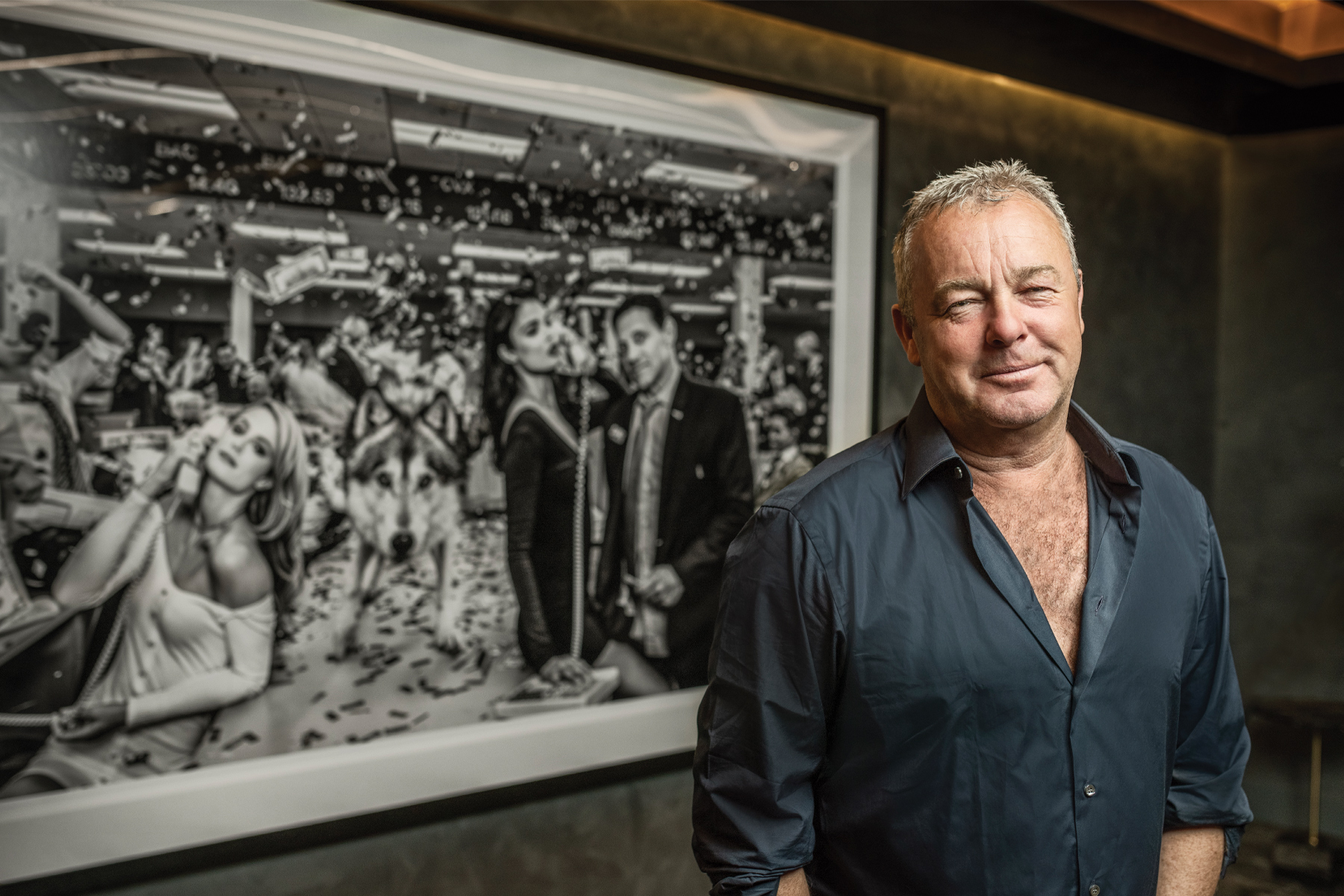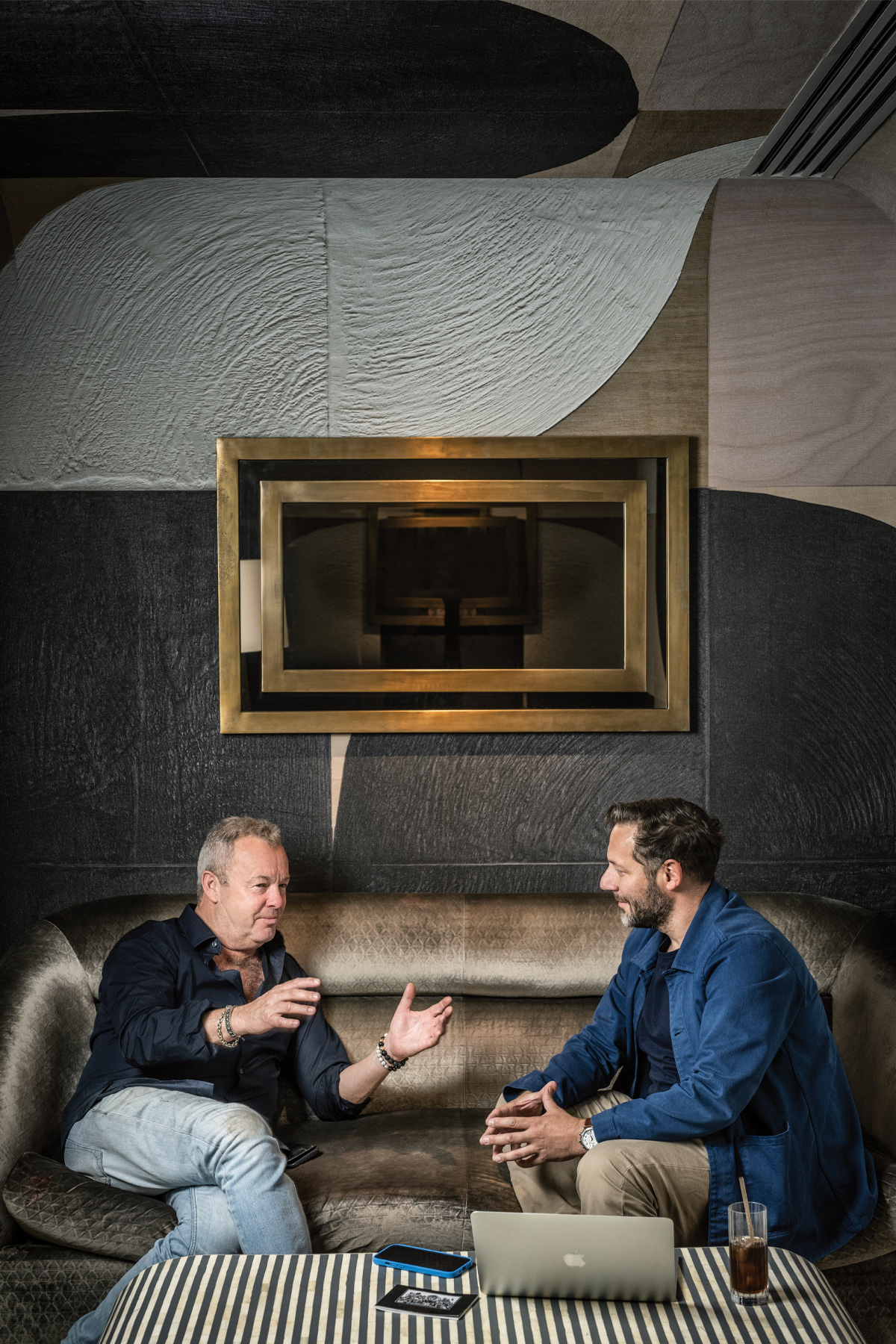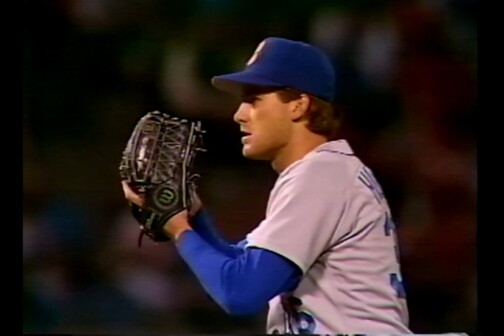A chance encounter in a gallery and a midnight dash on a private jet from New Orleans led to David Yarrow, one of Europe’s best-paid photographers, standing on Commerce Street in downtown Dallas, masterminding a photo shoot so ambitious that it wound up involving Homeland Security. The legendary British snapper is known for his big-budget cinematic set pieces, often involving wild animals, but on that particular morning, even he was worried that he’d bitten off a little more than he could chew.
“It was a total nightmare,” says the affable, straight-talking 56-year-old, laughing as he recalls the February 2020 shoot. “There were a ton of moving parts: horses, trucks, longhorn cattle, and a dozen Dallas Cowboys cheerleaders, all at this major downtown intersection that had been closed to traffic. But what I was most worried about was the weather. I wanted it to be cloudy and moody because I always photograph against the light, not with it. But of course this is Texas, so the sun broke through just as I started shooting.”
Relaxed and raffish as we chat over lunch at Catbird in the Thompson, Yarrow exudes the kinetic energy of a man half his age, waving his arms theatrically as he details the hurdles that he and his 50-strong team had to jump over that morning. There’s something piratical about him, his wrists rattling with bracelets and his linen shirt unbuttoned almost to the navel.
Despite his misgivings on Commerce Street, Yarrow did precisely what he always does: he got the shot. And not just any shot either: The Dallas Cowboys—featuring the longhorns, the cheerleaders, and a suitably moody cityscape behind—is now a colossal mural adorning a wall in the East Quarter, off Elm Street.
Yarrow, whose latest exhibition opens at The Thompson on November 3 and moves to Samuel Lynne Galleries the following Saturday, is a fully paid-up member of the Jim Richardson school of photography. Namely: “If you want to be a better photographer, stand in front of better stuff.” He’s made a career out of doing just that, traversing the globe from the highest Arctic to deepest Africa to shoot apex predators up close in their natural habitats, as well as supermodels and NFL quarterbacks—sometimes all together in the same frame.
“When I’m planning an image, I’m like a chef, assembling all the ingredients I’ll need, plus extra spices to marinate with,” he says, as our dishes arrive. “You need all those component parts, because we’re normally in a situation where we can’t shoot tomorrow; it has to be today. If you have a model who costs $30,000 a day, then we have to shoot today. If a blizzard appears, then we have to work with that blizzard. The important thing is to get one shot. If you turn around after spending $100,000 on a day’s shoot and you don’t have a good image, then you’re in trouble. And I’m Scottish, so I’m tight.”
Yarrow’s appearance in Dallas again next month is not a coincidence. In the three years since that big downtown shoot, this has become his de facto U.S. base—specifically The Thompson, where $1 million of his artwork adorns the walls and he has a suite on standby. Yarrow now reckons he spends an average of 60 days a year in Dallas, with Texas forming the backdrop to many of his most recent shoots, which all come together under a loose “Wild West” theme. And he sells more work here than he does anywhere else in the world, thanks to his partnership with the Samuel Lynne Galleries.
“I tell people who haven’t met David that if you combined the photographic genius of Ansel Adams with the larger-than-life experiences of Ernest Hemingway and then throw in a Scottish brogue, you have a pretty good idea of who he is,” says J.D. Miller, the gallery’s owner. “He brings a fresh perspective to his observations of the American West. And as an avid student of films by directors like John Ford and Steven Spielberg, he tends to view our landscapes from a grand cinematic point of view. People in Dallas love him because his work is larger than life, and it shows very well on the huge walls of Dallas homes. In Texas, we tend to go big or go home, and Yarrow does that in spades.”
For Yarrow’s part, he knew next to nothing about Dallas before boarding that private jet from New Orleans in the dead of night, but he’s had plenty of time since to get fully acquainted with the city. “When I first arrived here, I didn’t know anything about the city at all; I thought Highland Park was a whiskey,” he deadpans in his deep Glaswegian burr. “But in the last couple of years, it’s become a home from home.
“The essence of Dallas to me is positivity. There’s a crackling, upbeat energy here, which I adore. I’ve never seen such ease of hospitality anywhere else in the world. Texans find it incredibly easy to welcome strangers like me, and I’m extremely grateful for that fact. New York, Chicago, and Los Angeles—these are all known quantities. But Dallas is a wild card, an unknown factor. It has that intrigue, that excitement. I love this city.”
The feeling, it appears, is mutual. Yarrow says he sells about $3 million of his fine art photography annually in Dallas. Along the way, he has picked up a coterie of heavyweight local fans, including Troy Aikman (an eager amateur photographer himself) and Dak Prescott, who has one of Yarrow’s images hanging in his home. Not to mention former President George W. Bush, who invited Yarrow for a private lunch at his library last year. The two discussed a broad gamut of topics, according to Yarrow, from artistic composition to 9/11.
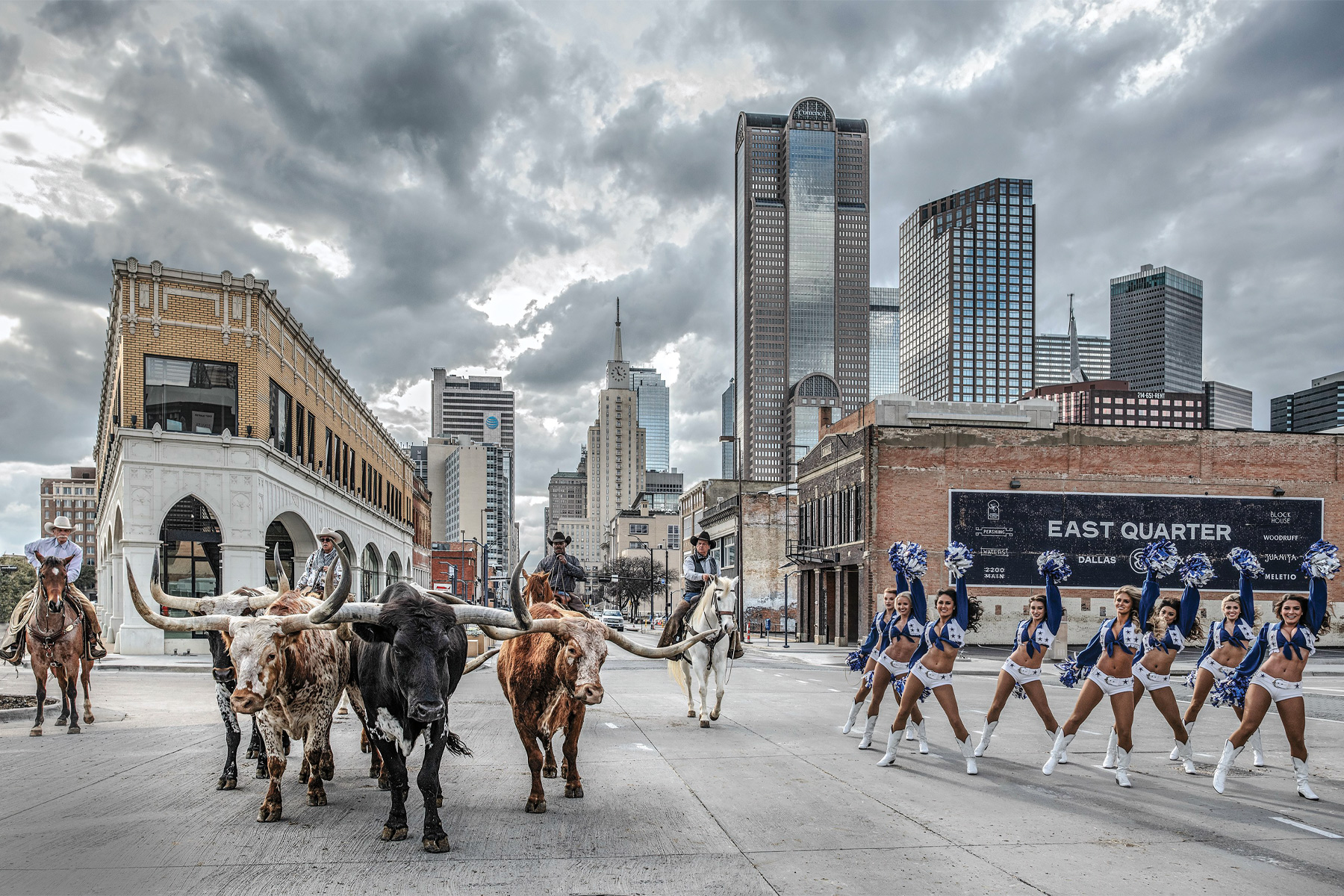
The photographer’s new show, which will run until December 3, is titled “Storytelling,” a theme at the heart of Yarrow’s creative process. Indeed, his style has been described as “equal parts Ansel Adams, the Coen Brothers, and Mario Testino” because he injects a distinct sense of narrative drama into his images.
“We’re all storytellers, but unlike a filmmaker who has two hours to tell a story, I have two seconds,” Yarrow says. “That’s why I have to use layers. You want to walk up to a photograph and something—or someone—in the foreground has to hit you straight away and drag you in. Once that’s happened, you can use the layers behind it to tell the rest of the story.”
That something or someone in Yarrow’s foreground has been a lion, a wolf, or a bear. On other occasions, it’s been a supermodel. The photographer has frequently worked with top-tier names such as Cara Delevingne and Alessandra Ambrosio (plus Broncos quarterback Russell Wilson, who, it turns out, is a surprisingly photogenic model). But there is one subject who, according to Yarrow, stands “on a pedestal way above” all the others. So much so that he always refers to her in hallowed fashion, by both her first and last name.
“There’s a big gap between the second-best person we’ve worked with and Cindy Crawford,” he says. “Cindy Crawford is the best by a long way. Just the goodness, the normality, the intelligence of Cindy Crawford. It all shines through. On a shoot, she’ll always go straight to the most marginal person in the room and make them happy. That’s just who she is. And not only that, but she’s always a good laugh. Cindy Crawford is the best model and the best fun.”
“What I was most worried about was the weather. I wanted it to be cloudy and moody because I always photograph against the light, not with it. But of course this is Texas, so the sun broke through just as I started shooting.”
The feeling is, once again, reciprocated. Tasked with writing the foreword for Yarrow’s new book—also titled Storytelling, it contains 130 of his most recent images—Crawford describes the “sense of camaraderie and excitement” about working with an artist who exudes “inspirational creativity” and “infectious generosity.”
That generosity has seen Yarrow—who is far from the penny-pinching Caledonian caricature he jokingly depicts—give away millions of dollars to charities over recent years, often in tandem with celebrity collaborators such as Crawford, Chris Hemsworth, and Tom Brady, who has a large Yarrow print hanging above his desk at home and wrote the foreword to the photographer’s previous book. In it, he compares Yarrow to an elite quarterback, working tirelessly to “achieve that one tiny, precisely focused frame or moment,” before hailing him for “sharing one perfect shot after another with the world.”
Yarrow’s rise to fame began in 1986, when he took an iconic image of Argentinian soccer player Diego Maradona raising the FIFA World Cup aloft in the minutes after the dramatic final against West Germany was won, surrounded by a jubilant flood of fans. The University of Edinburgh graduate was only 20 years old at the time and had bribed a stadium security guard with whiskey in order to get on the pitch.
“That picture taught me a fundamental lesson about photography, which I’ve never forgotten,” he says. “The importance of getting close to your subject.”
It’s a lesson Yarrow has applied through his career, often coating his camera casing in a variety of scents to entice dangerous animals right up to his lens. He says he’s not afraid of the teeth and claws, because animals are far more predictable than humans, especially when you have the right guides on hand. “We’ve shot many times with bears, lions, tigers, and wolves, and I’ve never once been scared of an animal experience,” he says. “Humans are far more dangerous than animals because they can do three things: they can get drunk, they can get high, and they can buy a gun.”

His worst experience on assignment, he says, was when he was taken hostage in South Sudan in 2014 and had a gun held to his head. But even then, he emerged from the trip with one of his most famous (and profitable) images of all, Mankind, a photograph of Dinka tribesmen herding cattle across a dusty plain.
Yarrow is, of course, primarily a photographer, but he’s also an astute businessman—which has attracted a certain amount of criticism within the British photographic scene in the past, as some feel his work is too commercially orientated, with a calculated aesthetic. It’s an accusation that Yarrow can afford to laugh off as he plans ever-more ambitious U.S. shoots. Brexit Britain is a place he feels less and less enamored with, he says, although he maintains a permanent base in the pretty seaside town of Salcombe, in Devon, about a four-hour drive southwest of London.
As part of his business model, Yarrow usually prints his best photographs in two runs of 12 each, and once they’re gone, they’re gone, allowing galleries to charge five- and six-figure sums for them. Even shooting in monochrome was a conscious business decision, as his pictures will suit any interior design, as long as the wall is big enough (which, for most of his elite clients, isn’t a problem).
“We’re all storytellers, but unlike a filmmaker who has two hours to tell a story, I have two seconds. You want to walk up to a photograph and something—or someone—in the foreground has to hit you straight away.”
“Someone said that if you photograph people in color, you see their clothes; if you do it in black and white, you see their souls,” he says. You also see the color of people’s money, it appears.
It was Yarrow’s business sense that first brought him to the attention of Shawn Todd, the Dallas investor and real estate developer behind the restoration of The National on Elm Street, as well as downtown’s East Quarter. Todd tracked down Yarrow after purchasing one of his prints as a gift for his son and then taking “a big gulp” when he later saw his credit card bill.
“The picture was amazing,” Todd says. “It was this mountain lion leaping out of an abandoned saloon in Wyoming, and the pounce as it emerges from the bar is just unbelievable. The camera is so close that it blew me away—and so did the price. So I spoke to J.D., the owner of the gallery, and I said, ‘If I’m paying this much, I’ve got to meet this guy. I’ve got to know how he does it.’ ”

When the two men finally got to speak, Todd asked Yarrow why he’d never shot in Dallas and offered up the East Quarter as a potential backdrop. Yarrow agreed, but his conditions were unexpected. “David calls me on a Monday and says OK he can do it, but he can only do it this Saturday,” Todd says, laughing. “Also, we have to pick him and his team up in New Orleans late at night—and we have to remove a traffic light on Commerce Street.”
The traffic light proved the most difficult piece of the puzzle, which bizarrely entailed getting permission from Homeland Security. Of course, as these things tend to do in the world of David Yarrow, it all came together at the last minute, and the two men now have an extraordinary image, and a genuine friendship, to show for it.
“Dallas is a can-do city, and that’s why someone like David fits in here so well,” Todd says. “There’s something very special about being a Texan: an entrepreneurial spirit coupled with a welcoming, open attitude, and David has plenty of that, too. His mindset, his creativity and positivity and ambition to get things done, matches Texas perfectly. That’s probably why we haven’t been able to get rid of him since that East Quarter shoot. He’s been bitten by the Texas bug—and I, for one, am glad of it.”



